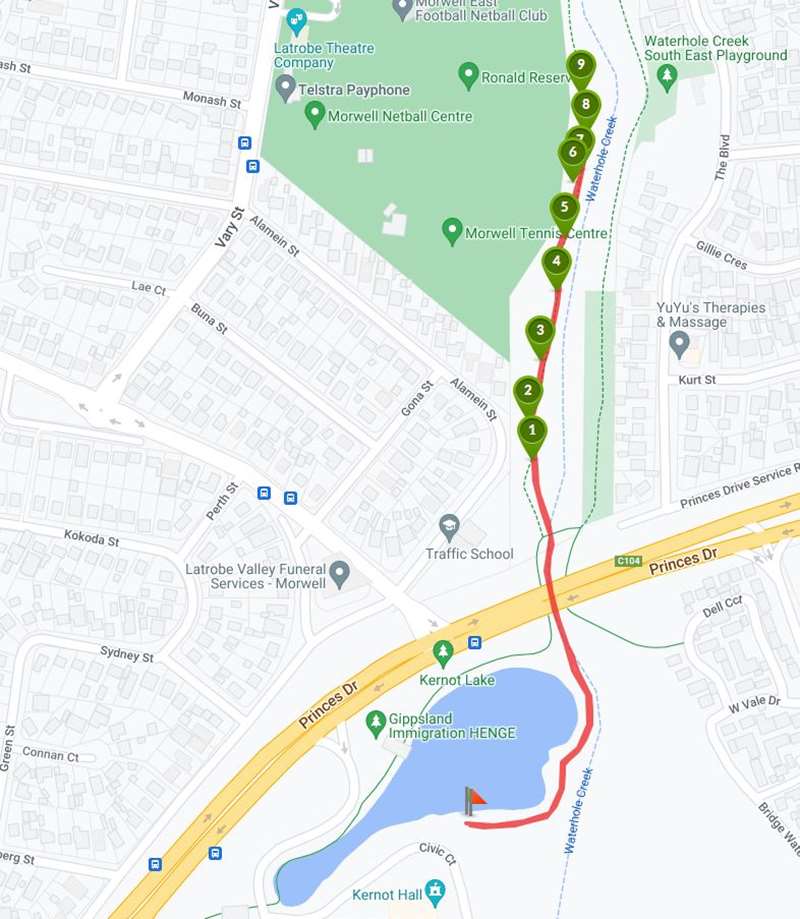Morwell - Waterhole Creek Aboriginal Cultural Heritage Trail

The walk along Waterhole Creek contains a series of boarded artworks by elder Uncle Ronald Edwards which explain Gunaikurnai's cultural heritage through stories and their meanings.
The simplest way to access this delightful walking trail is via the Gippsland Heritage Walk, located in the Gippsland Immigration Park beside Kernot Lake on Princes Way in Morwell.
At the northern end of the Heritage Walk, a sign directs you to the start of the cultural trail that begins at the underpass (with murals on the walls and bridge bollards painted in the colours of the Aboriginal flag).
Upon exiting the underpass, a bush-tucker garden is becoming established and the welcome mural and introductory signage created by artist and Gunaikurnai man Ronald Edwards gives context to the various murals, each providing a description on the back of the artwork.
Having lived in Gippsland for thousands of years, the Gunaikurnai nation is one of the biggest contemporary Aboriginal populations in Australia. Traditional designs captured by Edwards give identity to Country as well as the stories and meanings of the Gunaikurnai's cultural heritage.
The Gunaikurnai nation is made up of five major clans with different markings, stories and different language groups. Its territory includes Gippsland's coastal and inland areas to the outer slopes of the Victorian Alps.
Unlike the artwork of northern Australia, dot paintings are not common to the Gippsland region. Typical designs are made up mostly of lines forming triangles and diamonds, with cross-hatch patterns another feature of the artwork. These designs have been passed down from generation to generation through story-telling and the sharing of knowledge.
Along the creek is an abundance of Common Reed (Phragmites australis) and various other native aquatic plant species.
There are patches of mature indigenous vegetation including the Black Wattle (Acacia mearnsii) used to create boomerangs and nulla nullas, Spiny-headed Mat Rush (Lomandra longifolia) whose leaves are used for basket-weaving and the seeds for bush damper and Kangaroo Apple (Solanum aviculare) used as a contraceptive, amongst other things.
The air is filled with the songs of birds such as finches, currawongs, magpies and parrots.
Map of Route

Interactive Map
Points of Interest
1. The Welcome Mural
Gunaikurnai artist Ron Edwards provides an excellent overview of the cultural trail and murals.
2. Introduction to the cultural trail
This mural is well worth reading as it provides the context for the cultural trail.
3. The bush tucker garden
Over 27 species of native plants are included in this garden, all with important roles to play in the wellbeing of the Gunaikurnai people.
4. The Creation story
This mural tells the Dreamtime story of Borun the pelican man and Tuk, his musk duck wife.
5. Basket weaving
Local plants within the Waterhole Creek catchment can be used to weave useful (& exquisite) baskets that the Gunaikurnai nation is famous for.
6. Meeting places
The gathering of the five clans and meetings with other nations is clearly depicted in this beautiful mural.
7. The five clans and their shields
Each of the five clans of the Gunaikurina nation has its own particular shield identifying the clan to which tribal members belong.
8. Snake mural
Framed by well-established trees, this mural is a wonderful depiction of an important story that details this dreamtime story.
9. A snake in the rain story
As with all the other murals, you will learn about the story that informs Edward's painting of the snake.
Location
50 Princes Drive, Morwell 3840 Map
Web Links
→ The Aboriginal Cultural Heritage Trail: Waterhole Creek (Walking Maps)











